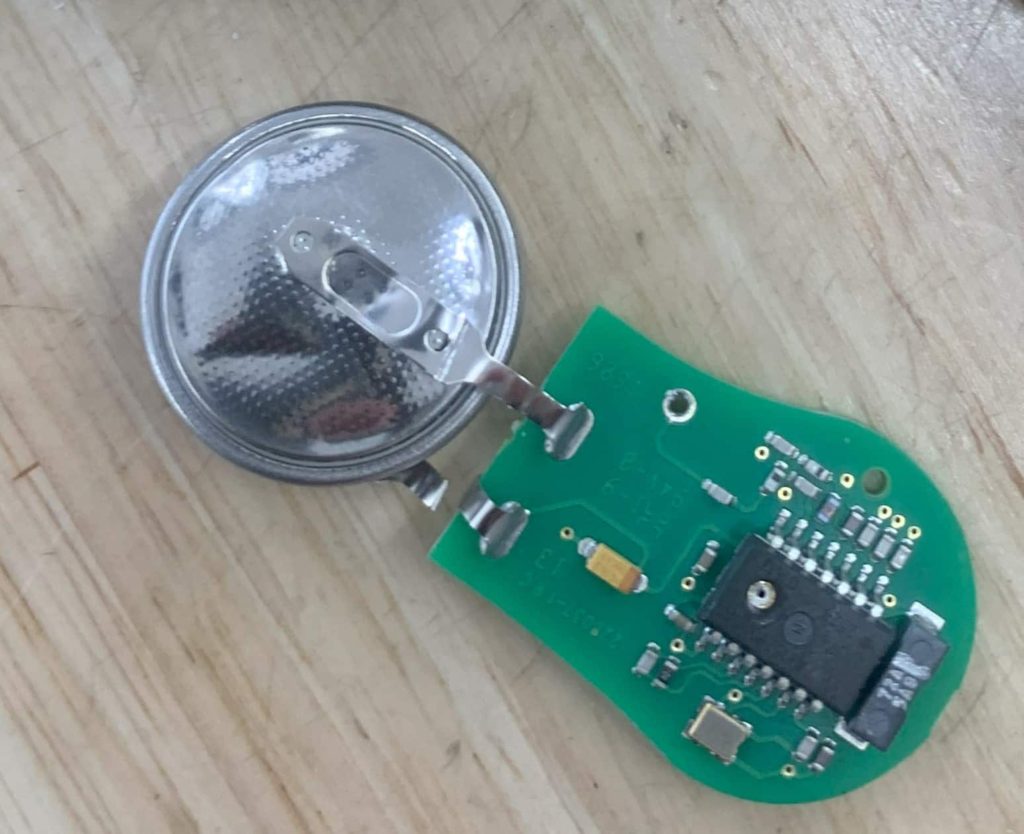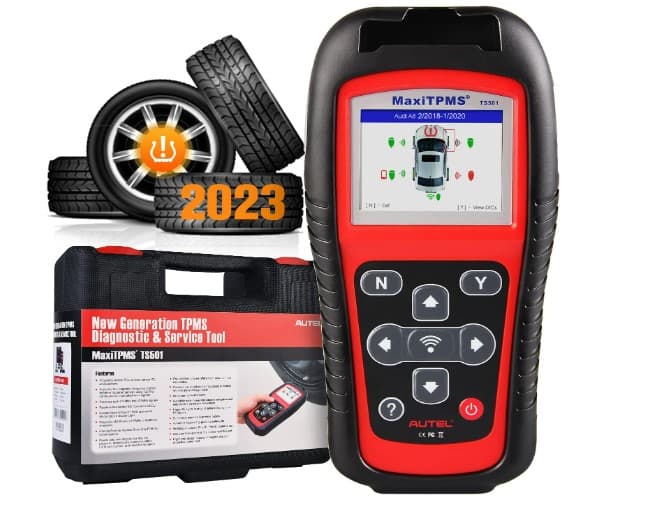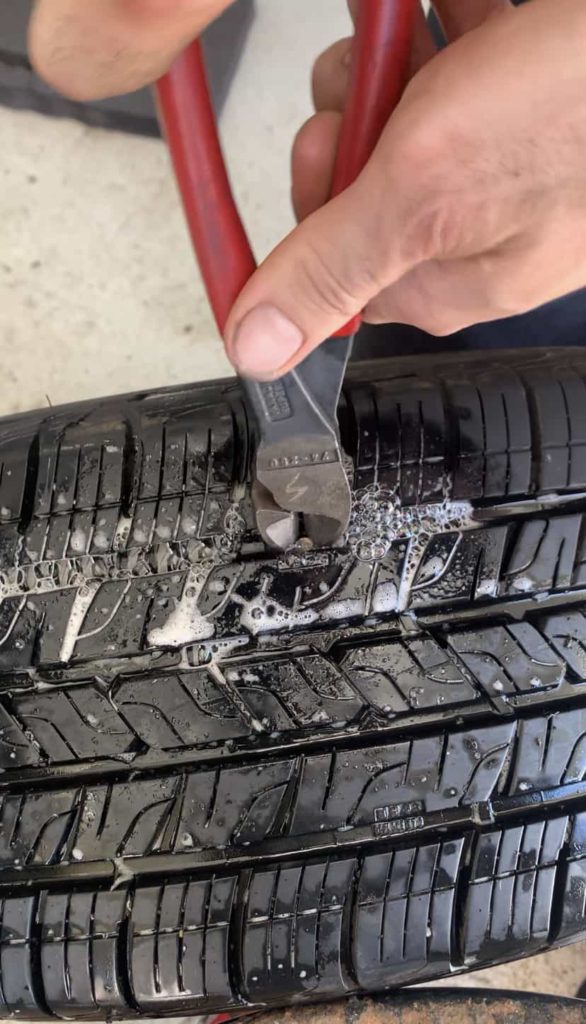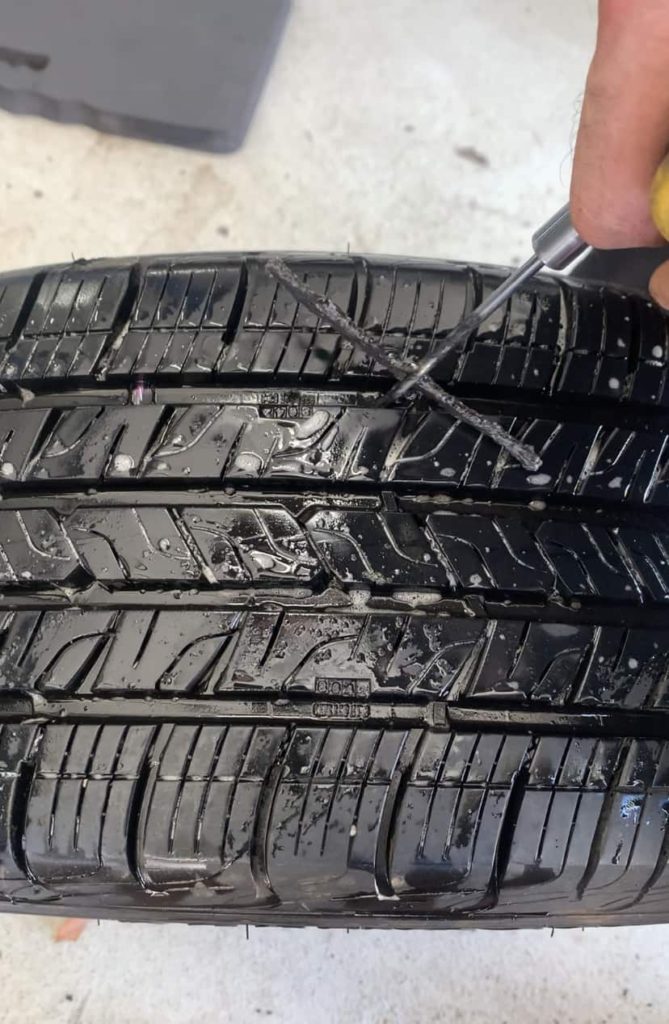What is the Ford F-150 Tire Pressure Monitoring System?
The Ford F-150’s tire pressure monitoring system serves to notify the driver both when tire pressure is problematic and when the monitoring system itself is malfunctioning. This system comprises sensors in each wheel for measuring tire pressure, a TPMS receiving unit, and a central computer known as the ECU.
Ford F-150 TPMS Components and How They Work
Tire-Embedded Pressure and Temperature Sensors: Inside each tire and connected to the base of each valve stem, tire pressure sensors continuously measure both the tire’s pressure and temperature once the Ford F-150 reaches 20Mph. They have a small plastic case with a circuit board and rely on battery-powered transmitters for operation.
Transmission of Wireless Signals: When driving the Ford F-150 or when a change in tire pressure is detected, the sensors wirelessly broadcast the collected data information. These sensors use either 315 Mhz or 433 Mhz frequencies to emit the data through Radio Frequency (RF) signals. (For sensor replacements, make sure the new sensor operates at the same frequency as the existing ones.)
TPMS Receiver Module: This is an additional circuit board/micro computer located within the vehicle that receives and interprets the wireless signals coming from the tire sensors. Upon receiving this data, it then sends it along to the F-150’s ECU.
Main Vehicle Computer, ECU: The ECU, standing for Electronic Control Unit, serves as the F-150’s main central processing unit. It analyzes the incoming tire pressure and temperature information and contrasts it with Ford’s recommended levels for the F-150. A low tire warning light gets triggered if the tire pressure drops by 15-20% below Ford’s recommended level.
Dashboard-Displayed Pressure Warnings: If the ECU determines that the tire pressure is beneath the recommended threshold, a warning light and message appear on the dashboard. The universal yellow or orange exclamation point is used to indicate low tire pressure. There are multiple different tire pressure warning messages on the F-150: “Tire Pressure Low”, “Tire Pressure Monitor Fault”, Tire Pressure Sensor Fault”, as well as multiple trailer tire pressure warning messages if towing a trailer.
How to Reset the Ford F-150 (2015-2024) Low Tire Pressure Light (Retrain TPMS Sensors)
Follow this procedure after tire rotations, tire replacements and any kind of tire service.
Set all 4 tire pressures to the exact pressures recommended by Ford.
Drive the Ford F-150 above 20 Mph for a minimum of 2 minutes.
Turn the ignition OFF.
Turn the Ignition ON with the Engine OFF. (Press the start button twice without foot on brake or turn the Key to position 2.)
Turn the Hazard Lights ON and OFF 3 times. (Press the hazard button 6 total times)
If steps 1-5 are completed correctly, the horn will beep once to indicate you are in RESET MODE. A message will also display on the information display screen. If
Get out of the truck and unscrew the valve cap from the front left tire. (driver side front.)
Press the valve stem core in to release air from the tire. Keep releasing air until you hear the horn beep. Once the horn beeps it indicates that the Ford F-150 ECU has learned the position of the wheel.
Move onto the front right tire (passenger side front tire) and remove the valve cap and begin releasing air. Once the horn beeps, stop releasing air.
Move onto the rear right tire (rear passenger side tire) and remove the valve cap and begin releasing air. Once the horn beeps, stop releasing air.
Move onto the left rear tire (drive side rear tire) and remove the valve cap and begin releasing air. Once the horn beeps, stop.
Turn the ignition of the truck OFF.
Inflate all 4 tires back to the recommended pressure values.
Drive the truck for a few minutes at speeds over 20 Mph.
Ford F-150 TPMS Reset Tips
If you do not hear the horn beep after step 5, start the process again.
Always complete the Ford tire pressure reset procedure in the order explained above.
If the horn beeps twice after turning the ignition OFF, repeat the entire procedure.
If a trailer tire pressure monitoring system kit is set up, this procedure also works for trailer tires.
How to Change the Ford F-150 Tire Pressure Measuring Units
Select SETTINGS (gear icon) on the touchscreen display.
Select GENERAL.
Select TIRE PRESSURE UNITS.
Select the desired pressure measurement. (Psi, kPa Etc.)
How to View Ford F-150 Current Tire Pressures
Drive the Truck at 20 Mph for a few minutes
Using the steering wheel controls select Main Menu on the information Display screen and Select Gauge Mode
Use the Right Arrow on the steering wheel to select it.
2023 Ford F-150 Tire Pressures & Wheel Size
TIRE SIZE | FRONT PSI | REAR PSI |
245/70R17 | 36 | 36 |
265/60R18 | 36 | 36 |
265/70R17 | 35 | 35 |
375/65/18 | 35 | 35 |
275/60R20 | 35 | 35 |
Different Ford F-150 Tire Pressure Warning Messages
After the tire light turns on, there are 3 possible tire pressure messages that will display on the information screen:
TIRE PRESSURE LOW
This message indicates one or more tires have low tire pressure and need to be inflated to the recommended pressures.
TIRE PRESSURE MONITOR FAULT
This message indicates an error or fault within the tire pressure monitoring system. The yellow exclamation point tire light will flash.
TIRE PRESSURE SENSOR FAULT
This message indicates one or more tire pressure sensors are not communicating with the TPMS receiver module.
What Will Cause the Ford F-150 Low Tire Pressure Light to turn On?
Tires with insufficient air pressure
Overfilled tires
Tire experiencing pressure loss
Missing pressure sensor in the wheel (e.g., when using the spare tire)
Faulty or depleted battery in tire sensor
Damaged TPMS receiver module
Electronic interference from adjacent Ford vehicles or gadgets
Variations in climatic conditions or altitude
Overloaded vehicle
Thick window tints
Operating with tire chains attached
Ford F-150 Tire Pressure Sensor Batteries
Every wheel of a Ford F-150 is equipped with an individual tire pressure sensor that operates on a unique silver-oxide battery. The sensor’s electronic circuit board is directly wired to the battery and is housed in a plastic enclosure. Due to its design, replacing just the battery isn’t an option; the entire sensor must be changed out. Typically, Ford’s tire pressure sensors have a lifespan ranging from 5 to 10 years or approximately up to 100,000 miles.
Diagnosing Ford F-150 Tire Pressure Light Problems
If the tire light is illuminated on your Ford F-150 dashboard, there’s an issue at hand. It might be due to under-inflated tires or a sensor failing to communicate correctly with the vehicle’s computer. If resetting the tire light does not work, here are six additional steps you can consider to find out why the tire light is on and how to fix it:
Solution 1: Is There a Tire Losing Air Pressure?
Should the tire light be illuminated on your Ford F-150’s dashboard, your initial step should be to identify whether any tires are deflating due to a leak. To do this, adhere to the following procedure:
Gauge the pressure in each tire to pinpoint the under-inflated one.
Inflate the identified low tire to its proper pressure.
Travel at a speed above 20 mph for approximately 3 minutes.
If the light extinguishes but reappears later—whether immediately, after a few hours, or even days—you probably have a leak in that particular tire. Now that you’ve isolated the problematic tire, refer to solution 6 to locate the source of the leak.
Solution 2: Clear the Diagnostic Trouble Codes (DTC) in the Ford F-150's ECU
Whenever the low tire pressure indicator illuminates on your Ford F-150, the truck’s Electronic Control Unit (ECU) stores this information as a Diagnostic Trouble Code (DTC). To erase these temporary codes, you can perform an ECU reset yourself. Initially, be sure the engine and all power to the truck is turned off (radio, lights, etc.). Next, detach the negative lead from the 12V battery, wait a few moments and then reconnect it. This will initiate a “relearning” phase of all the truck’s sensors and computers. We recommend driving at a steady 50 mph for roughly half an hour afterward to get everything working properly again.
Important: If the low tire pressure indicator extinguishes upon reattaching the battery but reactivates either during or after driving, this usually suggests that either the tire pressure sensor in one or more tires is defective or low on battery, or there’s a leak in your tire.
Solution 3: Diagnosing a "Tire Pressure Monitor Fault" or "Tire Pressure Sensor Fault"
If the Ford F-150 displays a warning message stating either “Tire Pressure Monitor Fault” or “Tire Pressure Sensor Fault,” this means that one or more of the tire pressure sensors are malfunctioning or having battery issues. To identify the specific sensor that is not operating as it should, you’ll require a TPMS diagnostic tool. Although there are various brands of these tools, they generally function in a similar manner. Initially, the diagnostic tool must be connected to the F-150’s OBD2 port to establish a link with the truck. Once connected, position the tool near the valve stem of the front-left tire and select the “trigger” or “test” option on the device. Wait for the tool’s response before proceeding to test the remaining three tires. At the conclusion of the test, the diagnostic tool will provide a summary of the condition of each tire pressure sensor. If a sensor is flagged as having a “low” battery or if the tool is unable to establish communication with it, that particular sensor will need to be replaced.
Solution 4: Activate a Sleeping TPMS Sensor
If you’ve attempted to recalibrate the tire sensors on your Ford F-150 without success, there’s an alternative method to awaken a dormant or problematic pressure sensor. Begin by releasing approximately 15-20 Psi of air from the problematic tire—gently press on the valve stem core to do this. Allow a moment to pass, then inflate the tire to a pressure level 5 Psi above its recommended setting. For instance, if the advised pressure is 36 Psi, inflate it to 41 Psi. Subsequently, drive for a few minutes at a speed greater than 20 mph. After driving, be sure to set the tire pressure back to the correct values and then go for another drive.
Solution 5: Tire Light Activates and Deactivates Automatically
Have you ever noticed that when you get in your Ford truck for the first time of the day your tire pressure light is on? Then when you start driving the low tire pressure light turns off on its own. This is because when tires are cool (from sitting and from a change in air temperature) the pressure decreases. This is referred to as “cold” tires. The extent of this pressure drop could be enough to activate the low-pressure warning light, particularly in colder regions or during the chill of the night. As you proceed to drive the truck and the tires start to heat up, the pressure will increase, which may consequently deactivate the warning light once it meets a certain threshold. To remedy this situation, we advise you to assess and inflate the tires when they are in a cold state (This is why owning a portable tire inflator is Fantastic!!). This ensures the most reliable pressure reading and can help stop the low-pressure warning light from intermittently turning on and off.
Solution 6: Find the Tire Leak
To identify the exact location of a leak in a tire you suspect is losing air, a straightforward method exists that requires only four items: a spray bottle, some soap, water, and a tire inflator. Begin by inflating the underinflated tire to a minimum of 35 Psi. Following that, put a bit of soap into the spray bottle and add water (a substance like Windex is equally effective). Generously spray the tire with this sudsy mixture, making sure to coat the full tire, including the valve stem. Once the tire is completely saturated, watch closely for the appearance of tiny bubbles. The formation of these bubbles will pinpoint the source of the leak. Spot the bubbles, and you’ve located the leak!
Ford F-150 Tire Pressure
How Much Does the Air Temperature Affect the Ford F-150 Tire Pressure?
The air temperature can have a notable impact on the tire pressure of a Ford F-150. Generally, for every 10-degree Fahrenheit change in air temperature, tire pressure will adjust by about 1-2 Psi. In colder climates, or during a cold snap, you could experience a drop of several Psi, which might trigger the vehicle’s low-pressure warning light. The opposite happens in hot weather conditions or after extended driving the tire pressure increases. Understanding this is particularly crucial for trucks like the Ford F-150 because it’s often used for towing or carrying heavy loads and maintaining the correct tire pressure is vital for both performance and safety.
How to Check Ford F-150 Tire Pressure
Park the Ford F-150 on a level surface and make sure the tires are “cold,” meaning the truck has been parked for at least three hours.
Locate the recommended tire pressure specifications on the white/yellow sticker inside the driver’s door jamb. Always go by this recommended pressure for front and rear tires.
Gather your tools: a digital tire pressure gauge and a tire inflator.
Remove the cap from the valve stem of the first tire you want to check. Don’t lose it!
Insert the tire pressure gauge onto the valve stem and take a reading.
Compare the reading to the recommended tire pressure. If it’s too low, use an air inflator to add air until it reaches the recommended level.
If the tire is overinflated, gently press on the valve stem to release some air until it matches the recommended pressure.
After inflating or deflating tires, always double check the pressures.
Screw the valve stem cap back on.
Repeat these steps for the remaining tires.
Why is Correct Tire Pressure Important?
Maintaining correct tire pressure in the Ford F-150 is crucial for optimal fuel efficiency, as underinflated or overinflated tires can reduce gas mileage and lead to increased fuel consumption.
Proper tire pressure is essential for safe handling and control of the truck.
Ensuring the right tire pressure extends the lifespan of your tires by promoting even tread wear, saving you the cost and hassle of frequent tire replacements as well as preventing excess tire waste.
Common Ford F-150 Tire Questions
Is it Safe to Drive the Ford F-150 With the Tire Light On?
As soon as a low tire pressure warning light turns on, stop driving and find out what is going on. Visually examine the tire and check the air pressure. Driving with the tire light on is not safe but to know how unsafe it is, you need to determine why the tire light is on.
Why is the Ford F-150 Tire Light Flashing?
If the Ford F-150 tire pressure light is flashing it means one or more tire pressure sensors have stopped communicating with the truck’s ECU or TPMS receiver module. This is known as a TPMS malfunction indicator light. This will usually happen when either a tire sensor is low or dead on battery power or one or more wheels does not have a tire pressure sensor inside it. For example, the spare tire of the Ford F-150 does not have a sensor in it so the truck is not receiving data from that wheel. The tire pressure light will flash and then stay lit everytime you drive the truck until the issue is fixed.
Are Tire Plugs Reliable for Fixing Tire Punctures?
Yes, tire plugs are extremely reliable for fixing punctured tires and I trust them in most situations. Do not use them if the tire tread is extremely low or on the sidewall of a tire.
Do Tire Sealants Damage Tire Sensors?
Tire sealants can damage tire pressure sensors as well as cause the tire to become imbalanced. We suggest only using tire sealants as a last resort.
Everything in this article is applicable to all Ford F-150 models and versions including the Ford F-150 XL, XLT, Lariat, King Ranch, Platinum, Limited, Tremor, Raptor, F-150 Powerboost hybrid and Ford F-150 Lightning.
Please note that this blog post contains Amazon affiliate links. This means that if you make a purchase through one of these links, we at TPMSRESET.COM may earn a small commission at no extra cost to you. We only recommend products that we personally use and believe in. Thank you for supporting us.









